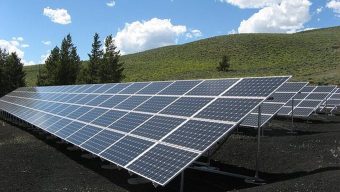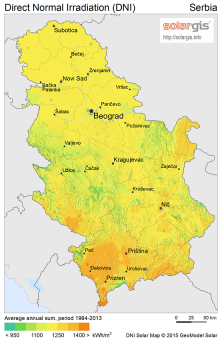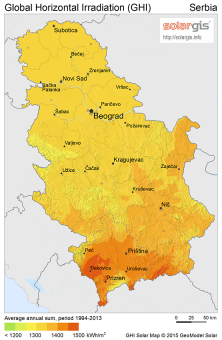Why should we use solar energy at all?
The sunlight is a source of energy that is responsible for favourable climatic conditions and for the existence of ecosystem on our planet. Most of the energy that is available on the Earth comes from the Sun, and even the energy that we exploit from the wind, water, biomass and all fossil fuels actually comes from this source. We can use this free, environmentally friendly and eternal source of energy with adequate technology.

Solar technology is already being used for the improvement of living standards. It represents a logical choice for facilities in remote areas in which the possibility of connecting to the grid is either hindered or it does not exist at all.
But this is not the only reason for its application. Solar technology also allows energy independence from the distribution grid for buildings with the existing connection.
By using this energy we can provide production of hot water and electricity from a renewable energy source that does not emit harmful gases, and thereby we also influence the mitigation of the resulting climate change.
How can we use solar energy?
We receive solar energy in the form of light and heat, and after its conversion in various solar systems, it can be used for obtaining heat or electricity.
There are two types of solar systems that are used for the production of electricity:
– Photovoltaic modules convert solar energy into electricity – the atoms emit electrons at the absorption of luminous energy and thus creating photoelectric effect.
– Solar energy is focused on mirrors and concentrators at the point of maximum production of heat energy from which electricity is produced by using conventional methods (steam turbine or otherwise).
What is the technical potential of solar energy in Serbia?
The number of hours of solar radiation on the territory of Serbia is between 1,500 and 2,200 hours per year. The average intensity of solar radiation is from 1.1 kWh/m2/day in the north and to 1.7 kWh/m2/day in the south during January and from 5.9 to 6.6 kWh/m2/day during July.
The average intensity of solar radiation is 1,200 kWh/m2/year in northwest Serbia, 1,550 kWh/m2/year in southeast Serbia, while in the central part is around 1,400 kWh/m2/year.
Serbia has significantly higher number of solar radiation hours than most of the European countries and the southeast part of our country has the best conditions. You can compare the average annual sunlight in different parts of Serbia on the attached maps.
 n_of_costs
n_of_costs 
The Government of the Republic of Serbia gave an opportunity for the construction of solar power plants through subsidies in Serbia for the first time by introducing the By-law on Feed-in tariffs for the production of energy from renewable energy sources and combined heat and power generation from 2009. After that, the Government has additionally increased the capacity and reduced the feed-in tariff through two new By-laws from 2013 and 2016.
Currently prescribed quotas of the Government of the Republic of Serbia for solar power plants are 10 MW, and this is divided in the following way:
– 4MW for solar power plants on roofs, but half of this is envisaged for small power plants up to 30 kW and the other half for the solar power plants from 30 kW to 500kW;
– 6MW is envisaged for the solar power plants on the ground.
In order to obtain the evaluation of production capacities on a certain location, depending on the radiation and latitude, you should enter the required information on the website of the European Commission’s Institute for Environment and Sustainability.
Multiannual overview of the electricity production in solar systems in Serbia can be found on the website of International Renewable Energy Agency (IRENA).
This link contains the World Atlas of RES and you can also find numerous maps of our country also with an overview of representation level of all types of renewable energy sources.
What is the benefit of investing in a solar power plant?
To begin with, it is necessary to emphasize that the benefit of installing solar panels for meeting your own electricity needs is only because a household can drastically reduce electricity bills. It is necessary to obtain a Decision in accordance with valid Law on Planning and Construction, Article 145 for the installation of the panels for this purpose. It is very important to make a good calculation especially if the goal is complete energy independence from distribution grid.
However, only investment in larger solar power plants can lead to profit but for their construction, it is necessary to meet technical, administrative and financial conditions and obtain a series of permits and approvals issued by competent state authorities.
Here you can find a detailed guide for investors in projects in the field of construction of plants and electricity generation from photovoltaic power plants in the Republic of Serbia that was prepared by the Ministry of Mining and Energetics and UNDP.
The advantages of investing in a solar power plant are the following:
*An incentive purchase price for electricity
Current incentive prices for electricity produced from solar power plants are shown in the table.

Source: Ministry of Mining and Energy, Decree on incentive measures
* The guaranteed purchase price for the period of 12 years for all the investors to whom the state has granted the status of privileged producers
* Relatively short period of investment’s cost-effectiveness – from 8 to 10 years
* Land of low use value (poor quality) can be used for a construction of solar power plants on ground in accordance with municipal spatial plans
* The possibility of using suitable roof surfaces of houses, halls and public buildings for the installation of panels
* Easy and relatively fast construction of small solar power plants
* Very low maintenance costs – the need for cleaning panels exists only during heavy snowfalls
* Low depreciation costs
* No noise or environmental pollution
How to make a good choice for solar power plant’s location?
Since the efficiency of solar power plant largely depends on the terrain and climatic conditions, pay attention whether the following conditions on the chosen location are met:
– Sufficient level of sunlight and favourable position of a plot or roof’s surface
– Availability of historical data on rainfall (such as the amount of snow, rain and cloudiness)
– Easy access to the site – which includes vicinity of the existing roads
– Existence of infrastructure on the site or its vicinity that could enable connection to the electric power line
– Location should not be near natural or cultural-historical property, within natural reserve or under the protection of the state
For precise calculation on the amount of produced kilowatt hours per year, as well as on the time frame for the return of the investment, it is necessary for the investor to hire experienced experts who will determine the justification of investing in a solar power plant based on the selected parameters.
Here you can see the list of projects which were implemented by Energy portal’s partner in this field
Do you have any doubts about investing in solar power plants?
Feel free to send us questions on info@energetskiportal.rs and our experts will try to answer as soon as possible.
Useful links:
Energy Agency of the Republic of Serbia
Ministry of Construction, Transport and Infrastructure
Guide to getting building permits
Provincial Secretariat of Vojvodina for energy, construction and transport
Environmental protection Agency
If you want to see the radiation maps, or to do quick calculations for applying of solar technology, open the following links:
http://resourceirena.irena.org/gateway/dashboard/?topic=4&subTopic=16



